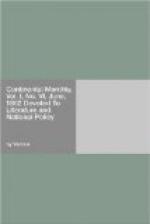In August, 1661, a number of Dutch and French emigrants from the Palatinate obtained grants of land on the south side of Staten Island, where a site for a village was surveyed. In a short time its population increased to twelve or fourteen families, and to protect them from the Indians, a block-house was erected and garrisoned with three guns and ten soldiers. Domine Drissius visited them, and from a letter of his to the Classis of Amsterdam, we learn the names of these early emigrants, and some are familiar ones[3], Jan Classen, Johannes Christoffels, Ryk Hendricks, Meyndert Evertsen, Gerrit Cornelissen, Capt. Post, Govert Lockermans, Wynant Peertersen, etc., etc. Previous to this period, the island had been twice overrun by the savages and its population scattered; but now its progress became uninterrupted and onward. Crowds of people from Germany, Norway, Austria, and Westphalia had fled to Holland, and their number was increased by the religious troubles of the Waldenses and Huguenots. Several families of the latter requested permission to emigrate with the Dutch farmers to New-Netherland, at their own expense. They only asked protection for a year or two from the Indians; and the English, now in possession of the New-York colony, were most favorably disposed toward them. This transfer from the Dutch to the British rule took place in 1664. Fort Amsterdam became Fort James, and the city took its present name, imposed as it was upon its rightful owners. Staten Island was called Richmond County, and the province of New-Netherland New-York, the name of one known only in history as a tyrant and a bigot, the enemy of both political and religious freedom.
[3: Alb. Rec. xviii.]
From 1656 to 1663, some Protestant emigrants from Savoy came to Staten Island, and a large body of Rochelle Huguenots also reached New-York during the latter year. This fertile and beautiful spot, with its gentle hills and wide-spread surrounding waters, became a favorite asylum for the French refugees, and they arrived in considerable numbers about the year 1675, with a pastor, and erected a church near Richmond village. I have visited the place, but all that remains to mark the venerable and sacred spot is a single dilapidated grave-stone! The building, it is said, was burned down, and none of its records have been discovered. At that period, there were only five or six congregations in the province of New-York, and this must have been one of them. The Rev. David Bonrepos accompanied some of the French Protestants in their flight from France to this country, and in an early description of New-York, the Rev. John Miller says: ’There is a meeting-house at Richmond, Staten Island, of which Dr. Bonrepos is the minister. There are forty English, forty-four Dutch, and thirty-six French families.’ In 1695-1696, letters of denization were granted to David Bonrepos and others. Among my autographs is a copy of his; he wrote a fair, clear hand.




